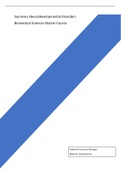Summary Neurodevelopmental Disorders
Biomedical Sciences Master Course
Radboud University, Nijmegen
Made by: Georgia Graat
,Neurodevelopmental disorders are diseases that arise during development of the child with
symptoms coming from the nervous system and thus brain function being affected. The most
common disorders are described in the DSM-5 as: ADHD, autism, conduct disorder, intellectual
disability, communication disorder, specific learning disorder, and motor development disorder. Rare
genetic syndromes, epilepsy, schizophrenia, and disruptive behavior disorder can also fall under this.
Neurodevelopmental disorders have certain overlapping defining characteristics, but these are not
universal or strictly adhered to.
1. Typical onset before puberty
2. Clinical course steady in the long term, rather than remitting/relapsing
3. Early onset neurocognitive deficits
4. More prevalent in males
5. High heritability with multifactorial etiology
6. High level of symptoms overlap, comorbidity and heterogeneity
Neurodevelopmental disorders actually have no universal
definition. They can be described as a wide range of
neurological and psychiatric problems involving some form of
disruption to brain development. The disorders also show a
high overlap in clinical traits, with main symptoms being more
extra symptoms in other disorders. The symptoms also seem
to change over life, usually with decline and more stability in
adulthood. Different patients therefore show different
outcomes later in life. The disease is always a life long course
of symptoms and treatment. Assessment and treatment
always requires specialists from a range of disciplines. Grouping of the disorders can be clinically
useful so the same specialists can treat children with different neurodevelopmental disorders. It has
to be taken in mind that children and adults need different care. All disorders also have a large
amount of co-morbidity or co-occurrence, meaning the same patient is diagnosed with several
disorders. This is always a heterogeneous symptom including more neurodevelopmental disorders or
other diseases. Some other aspects that are always seen in neurodevelopmental disorders regarding
patient differences are:
Clinical heterogeneity → different patients with the same disorder have different patterns and
clusters of symptoms
Etiological heterogeneity → different patients with the same symptoms and/or disorder can have
different causes at play for this
Treatment heterogeneity → different patients with the same symptoms and/or disorder can have
differences in their treatment response
Neurodevelopmental disorders can be viewed as categories or as
dimensions/continua. Categories division means you either have the disease or
not. The advantages are easier access to treatment, aids in clinical decision making,
and includes impairment. Dimensions division means you see the disease more as a
spectrum where everybody falls on and you have the disorder from a certain severe
threshold. The advantages are no artificial cut-off, a better reflection of underlying biology,
statistically more powerful, and similar prognostic, genetic and neuroimaging correlates as diagnosis.
, The endophenotype concept is defined as the measurable components
‘’unseen by the unaided eye’’ along the pathway from clinical phenotype
to distal genotype. An endophenotype can be neurophysiological,
biochemical, endocrinological, neuroanatomical, and cognitive. It
includes heritable biomarkers with a dimensional trait that show why
and how the genotype leads to the phenotype. The endophenotype as
we know it, has three underlying hypotheses/predictions: 1) closer to
genetic effect than the original diagnosis, 2) stronger effect of risk genes
on endophenotype than on clinical phenotype, 3) and/or few genes
involved with lower genetic complexity. There are several criteria for something to be an
endophenotype:
1. Endophenotype is associated with the disorder in the population
2. Heritable biomarker
3. Primarily state-independent meaning it manifests in an individual whether or not the
disorder is active
4. Within families, the endophenotype and disorder co-segregate
5. The endophenotype in affected family members is also found in nonaffected family members
at a higher rate than the general population
The original concept is however outdated. We see
that most behavior from complex traits to
phenotypes are heritable. Most are multifactorial
and highly polygenic with the environment also
playing a large role. The genes only provide a recipe
but not the blueprint for the disease. Genes act
mostly probabilistic and there is more a complex
interaction going on at different levels from genes
to brain to cognitive function to behavior.
Autism spectrum disorder
Autism spectrum disorder includes many different disorders under the same principal diagnostic
label so it turns into one disorder with different spectra. It falls under the neurodevelopmental
disorders as one of the most common. Autism knows two main symptom areas:
- Social-communication deficits
o Lack of social understanding/reciprocity/initiations
o Less affection / self-sufficient
o Non-verbal behaviors (eye contact, gestures)
o Atypical intonation, rate, volume of speech
o Idiosyncratic language
o Echolalia (delayed speech) or language delay
- Fixated interest, repetitive behaviors and abnormal sensory responses
o Hand/finger/complex mannerisms
o Excessive interest in highly specific topics
o Compulsions/rituals
o Unusual sensory interests
o Sensory aversions





